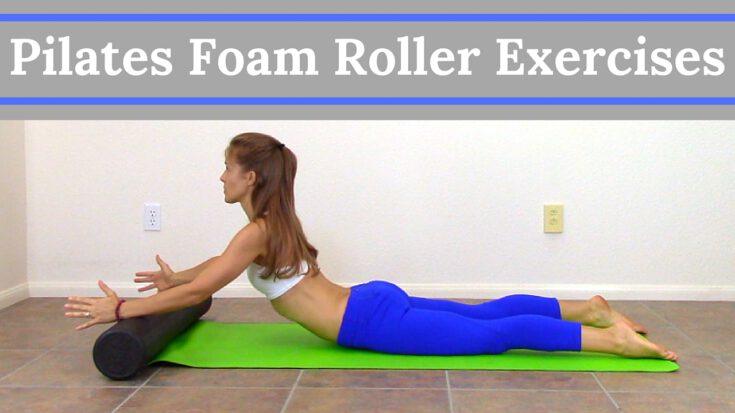I love Pilates and I teach Pilates, but Pilates isn’t the only kind of exercise I do. I walk, hike, and lift weights. I take yoga, barre and BodyPump classes. I do push-ups, dips and planks. I have a routine that works for me and my weekly plan usually involves bits and pieces from all of those things. One of the main components to my strengthening routine is a combination of squats, lunges and deadlifts.
This wasn’t always the case. I spent the entire first half of my life looking for the “perfect” exercise to tone my legs. I played soccer until I was 20 years old, so that helped keep me thin, but not toned. I started Pilates when I was 22, and I immediately noticed a difference in the look of my legs. I added some strength training with machines a few years later, and all of this really helped keep me healthy, strong and injury-free during all of my other activities (including my one and only half-marathon).
Despite all of this, I still felt my booty wasn’t quite as strong as it could be. I knew this wasn’t because I needed to exercise MORE, but I needed to target things differently. I wasn’t quite challenging myself to do the exercises that would improve that specific area of my body. Basically, I was kind of happy in my status quo exercise routine and didn’t want to make myself do something different or hard. I wanted to THINK about doing exercises to help my buns, but I didn’t really want to step outside of my comfort zone to DO those exercises.
After I had my baby, that all changed. Long gone were the days of having 20 minutes to drive to the gym, one hour to spend there, and 20 minutes to drive home. Or the days of doing my beloved one hour long Pillbox Trail runs. I had 30 minutes tops between feedings and emails and cleaning and work, so I had to make it good. I was forced to challenge myself if I wanted to see results. It was time for me I to face my nemesis – the SQUAT (cue scary music here).
There are obviously other parts to my workouts, and I’ve been able to increase my workout time a little again as my daughter has gotten older, but one of the keys to my stronger legs and booty these days is the addition of regular squats, lunges and deadlifts. I don’t just stand and do hundreds of these exercises! That is just too boring and my muscles would get used to that. I vary it up and do different tempos, different weights, and different positions and I incorporate them into my Pilates and yoga routines. It might not seem exciting, but these tried and true exercises really are effective for strengthening the lower body. The key is doing them correctly!
Today we are going to focus on these three exercises and the proper form for each. There are a couple of things I want you to know before we get started:
1) You don’t have to use any weights. If you are just starting, do these without any hand weights and only add weight when they have become easy. For the lunges and squats, I usually hold 10-12 pounds in each hand. For the deadlifts, I use 30-40 total pounds. Start light and work your way up!
2) You should NOT have pain with these exercises. Knee pain is so common with all of these, and it can usually be reduced by achieving proper form. If it doesn’t, please do NOT push through the pain! You will just make it worse. It’s much better to do a smaller range of motion and have no pain. Over time, as you strengthen, you will most likely have a larger range of motion. If you can’t do them at all without knee pain, don’t give up all together! There are routines I like to give to my physical therapy patients to help strengthen the muscles around the knee, and you could always start with those. If you’d like a future post with those exercises, please leave a comment below!
3) I don’t always like to give reps, as it will depend on your activity level, how much weight you are using and what variation you are performing. In general, I personally do these exercises as pictured 2x/wk, and I do 50-100 squats, 50 lunges on each side and 45 deadlifts (broken up over 5-6 sets!). If I do a BodyPump class and these are incorporated, I’ll only do them one other time during the week.
4) As always, check with your doctor before starting a new exercise routine.
SQUATS
What you are working:
Quads, Glutes, Hamstrings
Position:
1) Stand with feet slightly wider than hip distance, and turn feet and knees slightly out (this is a very small turn out!)
2) If you are holding weights, you can hold them at your chest or down by your sides.
Movement:
1) Bend your knees and sit your booty back, like you are going to sit in a chair.
2) Only go as far as is comfortable for you. The farthest I would ever go is thighs parallel to the ground (I personally don’t like to have people go lower than this due to patella tracking)
What to watch for:
1) Do NOT let knees go farther forward than your toes!
2) Keep your abs tight and your core engaged
3) Do NOT let your back over arch! Keep a flat spinal position.
4) Keep more weight in your heels than your toes.
LUNGES
What you are working:
Quads, Glutes
Position:
1) Take a very wide stance. When your knees bend, you should have your front knee directly over your ankle and the back knee aiming directly down towards the floor.
2) Keep your back heel lifted.
Movement:
1) Start standing with both knees straight and one foot forward and one back. Again, have a very wide stance, and both feet should be facing forward.
2) Bend the back knee towards the ground. The front knee will also automatically bend. Think of trying to get the front thigh parallel to the ground. You do NOT need to have the back knee touch the ground!
3) Then stand back up so both knees are straight.
What to Watch For:
1) Do NOT let the front knee go forward past the toes.
2) Keep your abs engaged and feel like your tail is tucked slightly underneath you.
3) Lunges are notorious for knee pain. This occurs because of the position of the kneecap and the weight bearing style of exercise. I avoid walking lunges because of this, and like to stick with stationary lunges as shown. Really watch for correct form and a wide stance, and double check your front knee is directly over your ankle when you bend your knee.
DEADLIFTS
What you are working:
Hamstrings, Glutes, Back Extensors
Position:
1) Start with feet slightly wider than hip distance in a standing position. Feet should be facing forward with a softness in your knees (don’t let them lock).
Movement:
1) Hinge at the hips to tip your torso forward until the weights are about even with your knees.
2) Keep your back completely flat as you hinge back up to a standing position. Slightly squeeze your glutes at the top of the motion.
What to watch for:
1) Your back needs to be completely flat during this exercise! If you let your back round at all you can cause back pain and problems and you won’t be working the correct muscles. This can be really hard to feel when you are new to this exercise, so use a mirror if you can. Another tip to help this is to keep your gaze forward when you hinge forward (illustrated in the photos below). Your body follows your eyes, so if you are looking down, you might round more.
2) Don’t let your knees lock. Make sure you keep them “soft”, which means just a slight bend.
3) While you are working your back extensors here, the main muscle groups working are hamstrings and glutes. If you feel only back muscles, please check your form, lighten your weight or do a smaller motion.
I hope this helps any of you wanting to add these exercises to your routine! It definitely is not needed to achieve a well-rounded program or stronger lower body, but they are great tools if you want to try. Let me know in the comments if this helped or if you have any other good tips and tricks!










